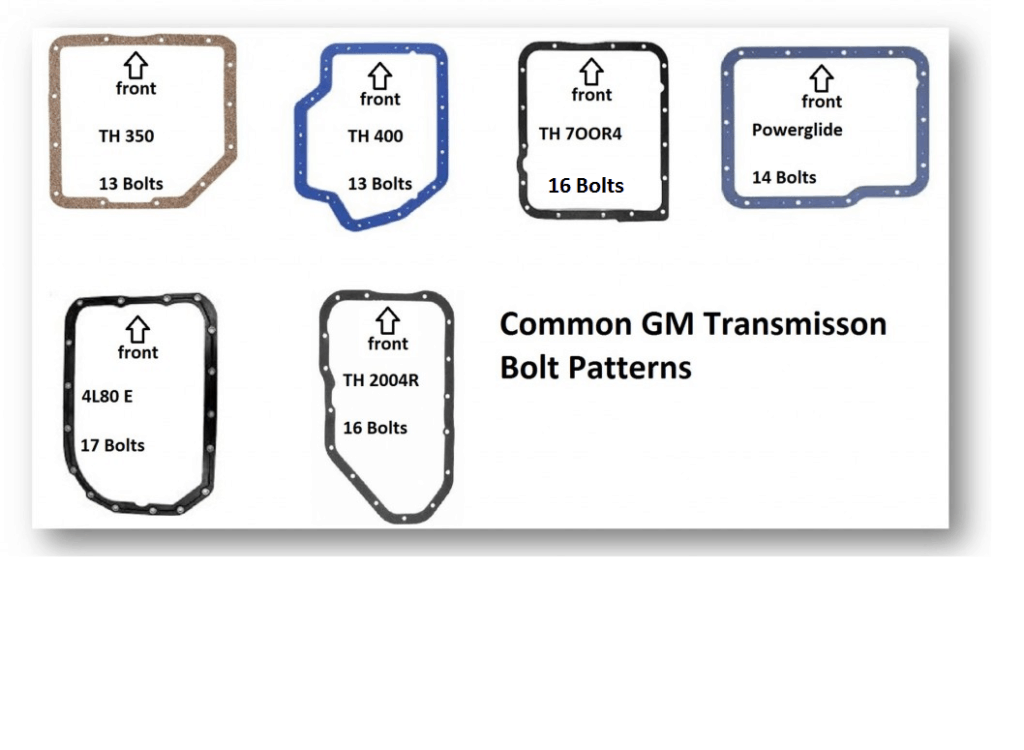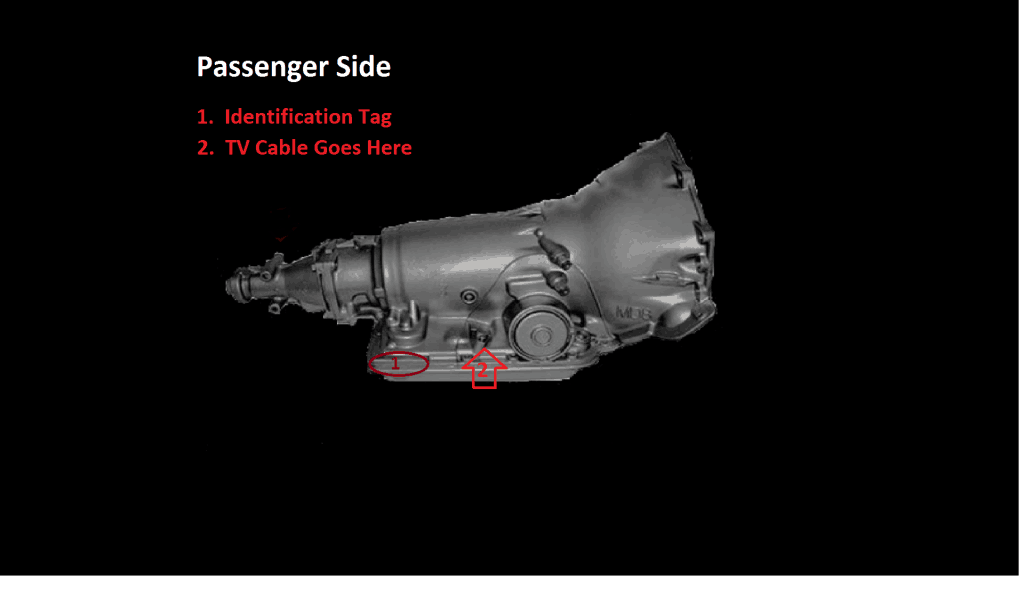
Using the pan bolt pattern and the number of bolts is the easiest way to ensure proper 700R4 transmission identification. If it has a 16 bolt rectangular pan with a TV Cable, that’s enough to confirm it’s a 700R4 right there.
To the untrained eye, nearly all GM automatic transmissions look the same. They are all made out of aluminum (except the very early Powerglide), have the same bellhousing bolt patterns, and have very similar case designs.
There are some things that you can do to make sure that you are correctly identifying the 700R4. It’ll look most similar to the 2004R at first glance. If you need to start from scratch, try this old article from Hot Rod.
One way to identify a 700R4 transmission is by examining the bolts around the transfer case. This transmission has a rectangular pan with 16 bolts, five down each side and three across the front and back. Another distinguishing feature is the rear output with four bolts.
Though the 700R4 and the 4L60 transmissions share similarities and even some parts, knowing these identifying features can help distinguish between the two and guide you in your search for the right transmission for your vehicle/
700R4 Identification- The Easy Way
The 700r4 transmission, also known as the TH700R4 or MD-8, is a popular and versatile transmission found in many GM vehicles during the 1980s and 1990s.
Key Characteristics for a Quick ID
To identify a 700r4 transmission, there are several key physical features to look for:
1. Input and output shafts: One of the easiest ways to identify a 700r4 transmission is by examining its input and output shafts. The input shaft should have 30 splines, while the output shaft should have 27 splines.
2. 16-bolt pan: The majority of 700r4 transmissions came with a 16-bolt pan from the factory, making it another useful identifying feature. Though exceptions may exist, this is generally a solid starting point.
3. Casting marks: Locate the bellhousing for any casting marks that may indicate it as a 700r4 transmission. Specifically, check for an “MD-8” casting mark, which is associated with the TH700R4.
4. Four-bolt rear output: Another distinct characteristic is its rear output, which should have four bolts. This is a primary differentiation between the 700-R4 and the 4L60 transmission.
Count the Bolts on The Pan
The easiest way to identify a 700R4 underneath the car is to look at the bolts. If you have a clear view of the transmission, count the bolts. Did you count 16? If you did, you have found a 700R4 or a 4L60. Remember, 4L60 was just another moniker for GM’s popular overdrive.
You want to ensure you don’t have a 4L60E on your hands, though. In most cases, if someone has told you that you are looking at a 700R4 and you count 16 bolts, you can be reasonably sure that you have found what you were looking for. But to be sure, check to see if the long “TV Cable” is attached to the Transmission.
If there is no TV Cable. Look at the tail shaft. If the speedometer cable is mechanical, then you have a 700R4. If it has wiring coming from it, you are looking at a 4L60E. Sometimes, when people don’t know what they are looking for, they search for an MD8 transmission. MD8 is stamped on the passenger side of most 700R4 cases.
700R4 Identification- With the Identification Tag:
Let’s say you found a transmission at a swap meet, on Craigslist, or at the salvage yard. Many people want to know exactly what year the transmission came from and what vehicle it was in.
The first digit of the Identification Tag will be the model number. It is not intuitive. The first units were for the 1982 model year. So you would expect the first model year ID number to be either 2(for 82) or 1, right? It’s not. It starts with a nine and then jumps to 3.

The model years are as follows:
| Year Manufactured: |
| 0=1990 |
| 1=1991 |
| 2=1992 |
| 3=1983 |
| 4=1984 |
| 5=1985 |
| 6=1986 |
| 7=1987 |
| 8=1988 |
| 9=1989 or 1982 |
- The second group of digits is the Model indicator. It’s two letters.
- After the model, the next area of the tag is the transmission type. It is one letter. In this case, M is the letter code for 700R4. 82-85 are missing this entirely. Try using the method above to figure it out.
- The fourth area is the plant that the transmission was manufactured in. It is one letter.
- The fifth line in the code is the serial number of the transmission. If the serial number is ground off it’s likely that it was rebuilt by GM at some point.
- The sixth line is the date of manufacture.
- The seventh line is the shift in which the 700R4 was built.
Decoding the Transmission Identification Number
The 700R4 transmission identification number is crucial for properly identifying and decoding the specifics of this transmission. Once you understand how to decode the identification number, it’s much easier to identify the transmission and its components. This section is divided into two subsections as follows:
Structure of the Identification Number
The 700R4 identification number is typically located on the passenger’s side of the transmission housing, towards the rear, just above the oil pan. It consists of a combination of numbers and letters that provide essential information about your transmission.
The identification number structure can be broken down into four main elements:
- Year of Manufacture: Represented by the first digit (e.g., “8”).
- Assembly Plant: Represented by a letter (e.g., “Y”).
- Model Specifics: Represented by one or two letters (e.g., “D”).
- Assembly Sequence Number: Represented by a series of numbers (e.g., “021”).
Using the sample code “8YDM021H,” you can now understand the structure of the 700R4 identification number.
Deciphering the Numbers and Letters
With the structure of the identification number clear, it’s time to decode the meaning of the numbers and letters:
- Year of Manufacture (8): The first digit represents the last digit of the year your transmission was manufactured. In our sample code, “8” would mean 1988 or 1998. However, considering the 700R4 ceased production in 1992, it indicates 1988.
- Assembly Plant (Y): The letter represents the plant where the transmission was assembled. However, there is limited information about the specific plant codes.
- Model Specifics (D or DM): The letters provide details about the particular model or specific components/features of the transmission. The exact meaning of these codes can vary depending on the source and availability of information.
- Assembly Sequence Number (021): The sequence number is not unique to a specific transmission but instead indicates the production order during the assembly process.
With this information, you can now decode the identification number of your 700R4 transmission and understand its specific details. Using the sample code “8YDM021H,” we now know this is a 1988 700R4 transmission of a particular model, with limited information about the assembly plant and specific features.
K Case
There was a 700R4 with a thicker case built for 4×4 trucks. It is known as the “K case” version because of the large K stamped on the bellhousing area.
This is undoubtedly the easiest way to identify it. It was made exclusively for four-wheel drive vehicles. They are commonly found on 80’s 4×4 pickup trucks. They are very desirable in the off-road community. This forum has good info on K cases.
Conclusion
As a footnote, if you buy a rebuilt unit from a reputable transmission shop or an aftermarket supplier such as TCI, it really should not matter what year it originally came from, as it will be totally gutted and rebuilt with much stronger components.
You should be able to find a reasonable one for around $900 that should handle at least 400 horsepower. It would certainly be in your best interest to ask what components were replaced. Many people feel that the input drum is the point of weakness for the 700R4.
If you feel like you could improve this post in any way, please feel free to comment.
Frequently Asked Questions
How do I identify a 700R4 transmission by its appearance?
To identify a 700R4 transmission, you can look for several distinct features:
- Input and output shafts: The input shaft has 30 splines, while the output shaft has 27 splines.
- 16-bolt pan: Most 700R4 transmissions come with a 16-bolt pan from the factory. While there are exceptions, this is a common identifier.
Remember, while these features can help you identify the 700R4 transmission, it’s still essential to verify the transmission’s model using other methods, such as casting numbers or vehicle compatibility.
What are the differences between 4L60E and 700R4?
The main differences between the 4L60E and 700R4 transmissions are:
- Electronically controlled: The 4L60E is an electronically controlled transmission, while the 700R4 is mechanically controlled. This means the 4L60E relies on the vehicle’s engine control module to manage gear shifting, whereas the 700R4 uses throttle valve cable inputs.
- Shift solenoids: The 4L60E has shift solenoids for more precise control over gear shifting, while the 700R4 lacks this feature.
- Transmission compatibility: The 4L60E is generally compatible with more modern vehicles, while the 700R4 is compatible with older General Motors vehicles (1982-1993).
Despite these differences, the 4L60E is essentially an upgraded version of the 700R4 with improved performance and reliability.
How can I find out the year of my 700R4 transmission?
To determine the year of a 700R4 transmission, you can look for the transmission’s identification number, which consists of a series of letters and numbers. This number is typically stamped on the passenger side of the transmission case, close to the pan rail.
The first character in the identification number represents the production year. The subsequent characters indicate the transmission model. Refer to a decoder or a transmission specialist to help you interpret the identification number and find out the year of your 700R4 transmission.
